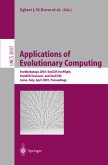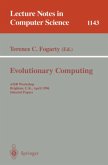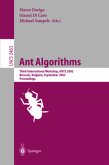This book constitutes the refereed proceedings of six workshops on evolutionary computation held concurrently as EvoWorkshops 2000 in Edinburgh, Scotland, UK, in April 2000.The 37 revised papers presented were carefully reviewed and selected by the respective program committees. All in all, the book demonstrates the broad application potential of evolutionary computing in a variety of fields. In accordance with the individual workshops, the book is divided into sections on image and signal processing; systems, controls, and drives in industry; telecommunications; scheduling and timetabling; robotics; and aeronautics.
The increasingly active eld of Evolutionary Computation (EC) provides val- ble tools, inspired by the theory of natural selection and genetic inheritance, to problem solving, machine learning, and optimization in many real-world app- cations. Despite some early intuitions about EC, that can be dated back to the - vention of computers, and a better formal de nition of EC, made in the 1960s, the quest for real-world applications of EC only began in the late 1980s. The dramatic increase in computer performances in the last decade of the 20th c- tury gave rise to a positive feedback process: EC techniques became more and more applicable, stimulating the growth of interest in their study, and allowing, in turn, new powerful EC paradigms to be devised. In parallel with new theoretical results, the number of elds to which EC is being applied is increasing day by day, along with the complexity of applications and application domains. In particular, industrially relevant elds, such as signal and image processing, computer vision, pattern recognition, industrial control, telecommunication, scheduling and timetabling, and aerospace engineering are employing EC techniques to solve complex real-world problems.
The increasingly active eld of Evolutionary Computation (EC) provides val- ble tools, inspired by the theory of natural selection and genetic inheritance, to problem solving, machine learning, and optimization in many real-world app- cations. Despite some early intuitions about EC, that can be dated back to the - vention of computers, and a better formal de nition of EC, made in the 1960s, the quest for real-world applications of EC only began in the late 1980s. The dramatic increase in computer performances in the last decade of the 20th c- tury gave rise to a positive feedback process: EC techniques became more and more applicable, stimulating the growth of interest in their study, and allowing, in turn, new powerful EC paradigms to be devised. In parallel with new theoretical results, the number of elds to which EC is being applied is increasing day by day, along with the complexity of applications and application domains. In particular, industrially relevant elds, such as signal and image processing, computer vision, pattern recognition, industrial control, telecommunication, scheduling and timetabling, and aerospace engineering are employing EC techniques to solve complex real-world problems.








